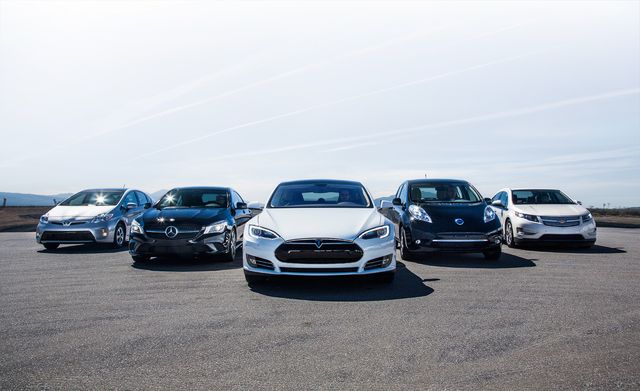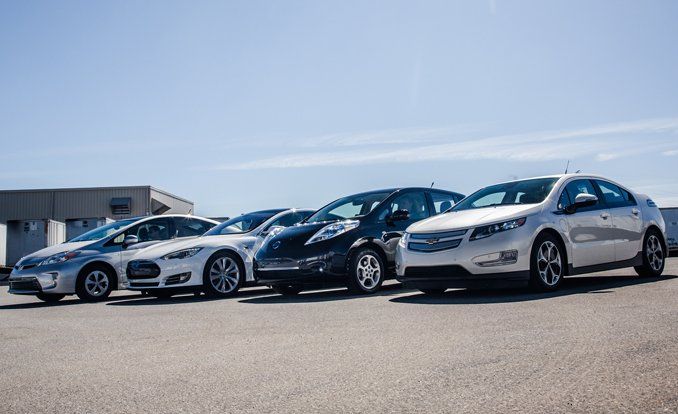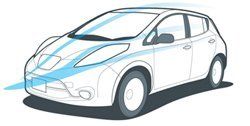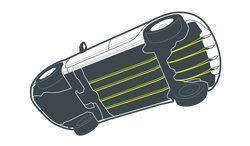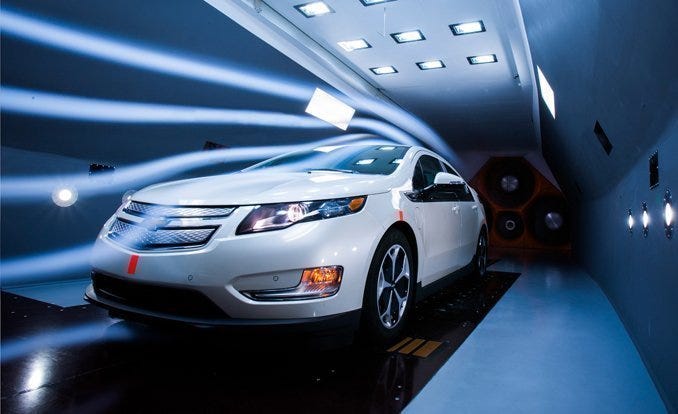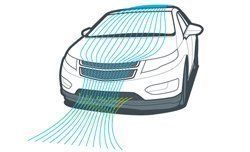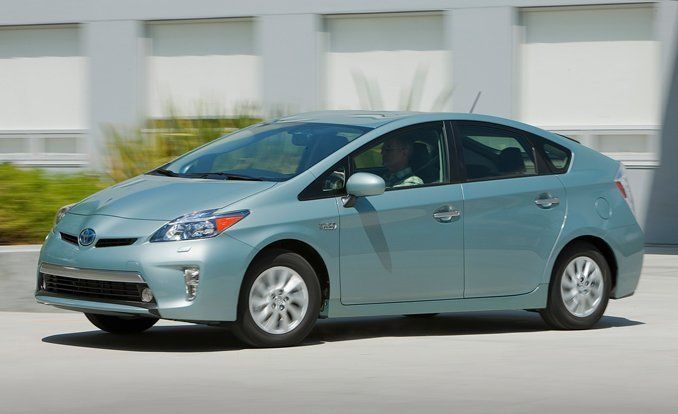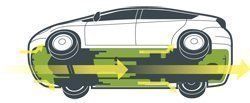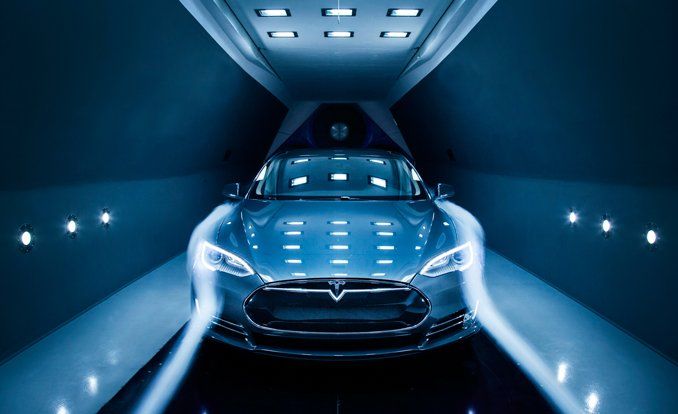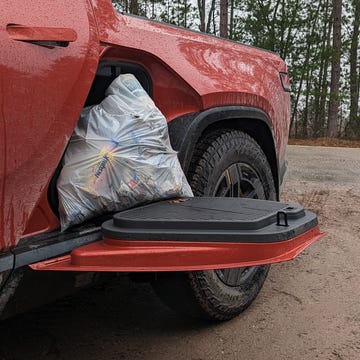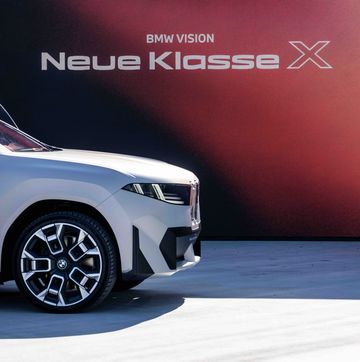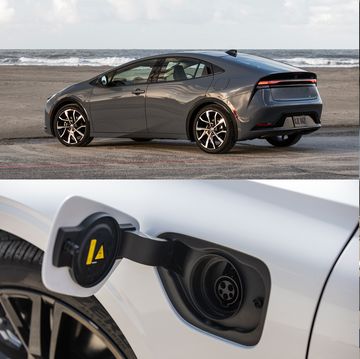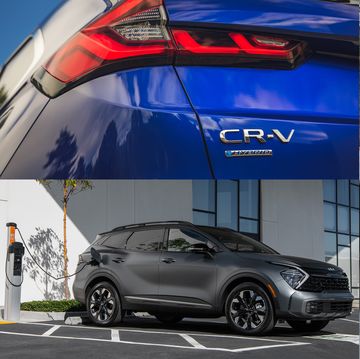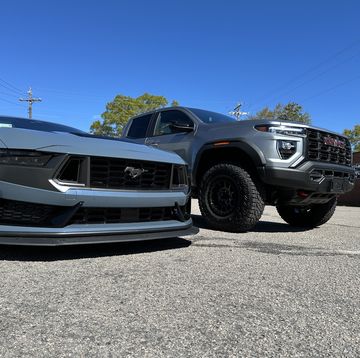From the June 2014 Issue of Car and Driver
Like a thief in the night, wind resistance is a stealthy intruder that saps your speed and murders your mileage without leaving fingerprints. The gentle murmur of air streaming over, under, and through your car belies the wind’s heinous ways.
Even if there’s no alternative to driving through Earth’s atmosphere, we can at least fight wind resistance with science. Aerodynamics—the study of air in motion—can lift our top speeds, curb our fuel consumption, and, if we’re smart about it, keep our tires stuck to the pavement.
Long before automotive engineers fretted over aerodynamics, aviation pioneers defined the basic principles of drag and lift. Inspired by birds and airships, early speed demons also toyed with streamlined shapes. The first car to crack 60 mph (in 1899) was an electrically propelled torpedo on wheels called, hilariously, “La Jamais Contente” (“The Never Satisfied”). Grand Prix racers took up the cause in the early 1920s; the following decade, Auto Union and Mercedes-Benz raced toward 300 mph with streamliners developed in German wind tunnels. Half a century after Chuck Yeager broke the sound barrier in flight, Andy Green drove his ThrustSSC a satisfying 763 mph across Nevada’s Black Rock desert.
Now it’s our turn. Car and Driver gathered five slippery cars to study their drag and lift properties at a wind tunnel whose name and location we swore not to reveal. We had two goals in mind: first, to learn the fine points of blowing air over automobiles in a test chamber; second, to determine which brand did the best job optimizing its car’s aero performance.
There are reasons why you haven’t read this story before. Every major carmaker owns and operates a wind tunnel, but those facilities are busy around the clock, as engineers work to stay ahead of the rapidly rising EPA-mileage tide. Inter-company rivalries are another issue foiling easy access. While manufacturers often tout the slipperiness of their products, comparisons with competitive models are rare.
The expert in charge at our clandestine test location explains: “All wind tunnels strive to accurately quantify the aerodynamics a car will experience in the real world. The vehicle and the tunnel constitute a system with complex interactions. As a result, drag and lift measurements on a particular vehicle can vary from one tunnel to another.”
A group of vehicles may rank differently in different tunnels, he says. This is why most manufacturers have so little faith in aero numbers measured outside their own facilities. Coast-down testing, which logs the car’s speed as it decelerates, is often touted as the better “real-world” measure of a car’s aerodynamic properties. “That may be true in principle, but accurate results are difficult to achieve in practice because variations in wind, driveline temperatures, and tire qualities influence the results. The beauty of wind tunnels is their tight control over variables.”
Our winner here will be the car with the lowest drag area, which is the product of the shape’s frontal area and its drag coefficient and the true measure of a car’s wind-cheating ability [see “A Somewhat Long-Winded Glossary” below]. With that, we humbly present our first ever aero comparo.
A SOMEWHAT LONG-WINDED GLOSSARY
Aerodynamic Horsepower: The power required to drive a vehicle through the atmosphere (not including driveline and tire-rolling losses). It increases with the cube of velocity, so aero power at 100 mph is 2.9 times the power requirement at 70 mph.
Drag Area: The product of the drag coefficient and frontal area is the best measure of any car’s aero performance because it’s directly proportional to the horizontal force measured in a wind tunnel and experienced on the road.
Drag Coefficient (CD): A dimensionless parameter used to quantify aerodynamic efficiency in the horizontal (drag) plane.
Frontal Area: The largest horizontal view of a car. We used a 200-mm camera lens positioned 150 feet from the vehicle to take a digital photo, which we analyzed using Siemens Solid Edge CAD software.
Lift: Air flowing over and under the car and through the grille can diminish wheel loading and, in extreme cases, deteriorate handling. Air dams and spoilers are effective countermeasures.
Wind Resistance (Drag): A force proportional to the drag area, it increases with the square of the vehicle speed.
Streamlines: Wind-tunnel operators add small quantities of smoke to the airflow to reveal how the wind moves around, under, or through the test vehicle.
Drag Area= 7.8 ft²
The Leaf is the boxiest shape we wheeled into the wind tunnel, and it has this test’s second-largest frontal area at 24.5 square feet. Combined with a 0.32 drag coefficient, that yields a 7.8-square-foot drag area. This is a reasonable figure for a five-passenger wagon and only 30 percent greater than the two-seat, bullet-shaped 2001 Honda Insight we brought along and tested for reference.
Bug-eyed headlamps stand proud of the Leaf’s V-shaped nose to nudge air away from the exterior mirrors, which are often a source of turbulence, drag, and noise. To maximize cabin space, the side windows are erect and the roof is as flat as a sheet of plywood. The tail of this hatch looks more like a wind-blocking phone booth than a sleek raindrop.
The Leaf’s underbody is flat and slippery (an increasingly common feature in new cars), with diffuser strakes molded into its rear fascia. A large radiator is unnecessary in a pure electric vehicle, so the only air entering the low grille is to cool electrical equipment and to ventilate the battery and interior. Air flowing through a car’s internal cavities is a prime source of drag and lift.
Nissan invested $5 billion developing the first mass-produced electric car sold across America. With any luck, there are a few yen left in the kitty to cut drag in the next generation.
Drag Area = 7.0 ft²
The CLA 250 has this test’s smallest frontal area. The drag coefficient we measured—0.30—is higher than expected for what Mercedes calls the aero benchmark for production vehicles. But it’s worth noting that Mercedes does not fit special features such as automatic grille shutters to U.S. models. And even though this sports sedan has a turbocharged engine and an automatic transmission to keep cool, its 7.0-square-foot drag area is competitive with the hybrids and electrics here.
Both ends of the CLA are aggressively tapered to cheat wind. Headlamps wrap back like the eyes of a Botox queen wearing her ponytail too tight. Mini spoilers under the car guide air around the front tires, and fairings smooth airflow beneath the engine and rear suspension.
The CLA’s roof sacrifices some rear headroom, but credit Mercedes for giving its entry model an aero design that achieves great fuel efficiency.
Drag Area = 6.7 ft²
The Volt’s midpack drag coefficient (0.28) and frontal area (23.7 square feet) earn it a drag-area score that’s, well, midpack. This plug-in hybrid’s conventional-looking grille is almost entirely blocked to divert air over the top and around the sides. That yields a 15-pound increase in front-axle loading at 70 mph, beneficial for highway stability.
The Volt’s front lamps extend all the way back to the wheels, and there’s a nicely shaped ski mogul from the top of the grille to the hatch’s trailing edge, providing a smooth course for slipstreams. Strut-mounted side mirrors make way for the wind. GM sculpted the Volt to keep airflow attached to the side surfaces as long as possible to reduce turbulence. The flat hatch extension helps to stabilize the car’s wake.
But even if the Prius and Volt tails look about the same, we measured 50 percent more rear lift in the Chevy. The 26-pound reduction in the Volt’s rear-wheel loading isn’t alarming, but it’s the kind of difference that tells you to trust the wind tunnel over your visual assessment of any car’s shape.
Drag Area = 6.2 ft²
Toyota’s long-running poster boy for hybrid technology finished a close second in our testing, with a tidy 23.9-square-foot frontal area and a clean 0.26 drag coefficient. The third-generation Prius, Prius C, and Prius plug-in are the most efficient hybrids on the market, in large part because they surrender so little energy to the wind. That results in 50 mpg in the EPA’s combined fuel-economy ratings and only 42 horsepower (versus the Volt’s already low 45) needed to overcome aerodynamic drag at 100 mph.
This car’s upper surface mimics an airfoil, one of the most efficient shapes for punching a clean hole in the atmosphere. The windshield blends into the roof with no extra moldings to trip airflow. Egg-shaped mirrors are well separated from the nearly flat side surfaces. The wheel-cover spokes are smooth to minimize churn.
A steeply inclined hood and controlled airflow through the engine/motor compartment yield 4 pounds of front downforce at 70 mph. Rear lift is only 17 pounds.
Drag Area = 6.2 ft²
The Tesla’s margin of victory over the Prius is buried in the margin of error common to wind tunnels. The S earns our top slot by virtue of its larger 25.2-square-foot face and lower 0.24 drag coefficient, which yield the same 6.2-square-foot drag area as the Prius. Low drag is a tougher challenge with a larger frontal area, hence the Tesla’s overall win. Exercise care when checking our math because the measurements were rounded at the end of calculations.
There’s more to the Model S than a pretty face and sleek exterior. The air suspension drops ride height at highway speeds (we tested in the low position). A contoured chin below the grille helps to keep airflow attached as it sweeps under the car’s flat bottom. The front fascia’s outboard corners deflect air around the tires. Shutters block three grille openings until internal heat exchangers require airflow. Spoilers and fences guide air away from the front wheelhouses, and exiting air is routed under the car instead of out the wheel openings. A rear diffuser straightens flow to minimize lift and drag while, on top, the optional carbon-fiber spoiler diminishes lift without penalizing drag.
The Model S’s aero polish came from computer simulations supplemented by wind-tunnel visits. Our road test of the Model S revealed a 134-mph top speed and a real-world 211-mile driving range. With taller gearing, a P85 Model S might reach 200 mph. Clearly, this is the aerodynamic electric car that merits intense scrutiny by the world’s carmakers. It proves that you can look slick and be slick at the same time.
| Vehicle | 2014 Chevrolet Volt | 2014 Mercedes- Benz CLA250 | 2012 Nissan Leaf SL | 2012 Tesla Model S P85 | 2014 Toyota Prius |
| Base Price | $34,995 | $30,825 | $38,100 | $93,390 | $29,245 |
| Price as Tested | $35,995 | $35,855 | $38,290 | $100,520 | $33,408 |
| Dimensions | |||||
| Length | 177.1 inches | 182.3 inches | 175.0 inches | 196.0 inches | 176.4 inches |
| Width | 70.4 inches | 70.0 inches | 69.7 inches | 77.3 inches | 68.7 inches |
| Height | 56.6 inches | 56.6 inches | 61.0 inches | 56.5 inches | 58.7 inches |
| Wheelbase | 105.7 inches | 106.3 inches | 106.3 inches | 116.5 inches | 106.3 inches |
| Weight | 3766 pounds | 3374 pounds | 3353 pounds | 4785 pounds | 3180 pounds |
| Powertrain | |||||
| Powertrain | DOHC 1.4-liter inline-4 + AC electric motor, CVT | turbocharged DOHC 2.0-liter inline-4, 7-speed dual-clutch automatic | AC electric motor, single-speed drive | AC electric motor, single-speed drive | DOHC 1.8-liter inline-4 + AC electric motor, CVT |
| Power HP @ RPM | 84 @ 4800 (engine) | 208 @ 5500 | 107 @ 10,000 | 416 @ 8600 | 98 @ 5200 (engine) |
| Torque LB-FT @ RPM | 271 @ 0 (motor) | 258 @ 1250 | 187 @ 0 | 443 @ 0 | 153 @ 0 (motor) |
| Driven Wheels | front | front | front | rear | front |
| Performance | |||||
| Acceleration | |||||
| 0–60 MPH | 8.8 sec | 6.3 sec | 10.2 sec | 4.6 sec | 10.0 sec |
| ¼-Mile @ MPH | 16.7 sec @ 85 | 14.9 sec @ 95 | 17.7 sec @ 78 | 13.3 sec @ 104 | 17.6 sec @ 79 |
| Top Speed | 101 mph (governor limited) | 133 mph (governor limited) | 94 mph (governor limited) | 134 mph (redline limited) | 115 mph (drag limited) |
| Fuel | |||||
| EPA City/Hwy | 35/40 mpg Performance results from C/D, November 2011. | 26/38 mpg Performance results from C/D, December 2013. | 126/101 mpge Performance results from C/D, March 2014. | 88/90 mpge Performance results from C/D, January 2013. | 51/48 mpg Performance results from C/D, July 2009. |
| C/D Wind TunnelTest Results | |||||
| Drag Coefficient | 0.28 | 0.30 | 0.32 | 0.24 | 0.26 |
| Frontal Area | 23.7 square feet | 23.2 square feet | 24.5 square feet | 25.2 square feet | 23.9 square feet |
| Drag Area (CD X Frontal Area) | 6.7 square feet | 7.0 square feet | 7.8 square feet | 6.2 square feet | 6.2 square feet |
| Drag Force @ 70 mph | 84 pounds | 88 pounds | 97 pounds | 77 pounds | 78 pounds |
| Aero Power @ 70 mph | 16 hp | 16 hp | 18 hp | 14 hp | 14 hp |
| Aero Power @ 100 mph | 45 hp | 48 hp | 53 hp | 42 hp | 42 hp |
| Front-Axle Lift @ 70 mph | -15 pounds | 46 pounds | -12 pounds | 23 pounds | -4 pounds |
| Rear-Axle Lift @ 70 mph | 26 pounds | 44 pounds | 11 pounds | 17 pounds | 17 pounds |
